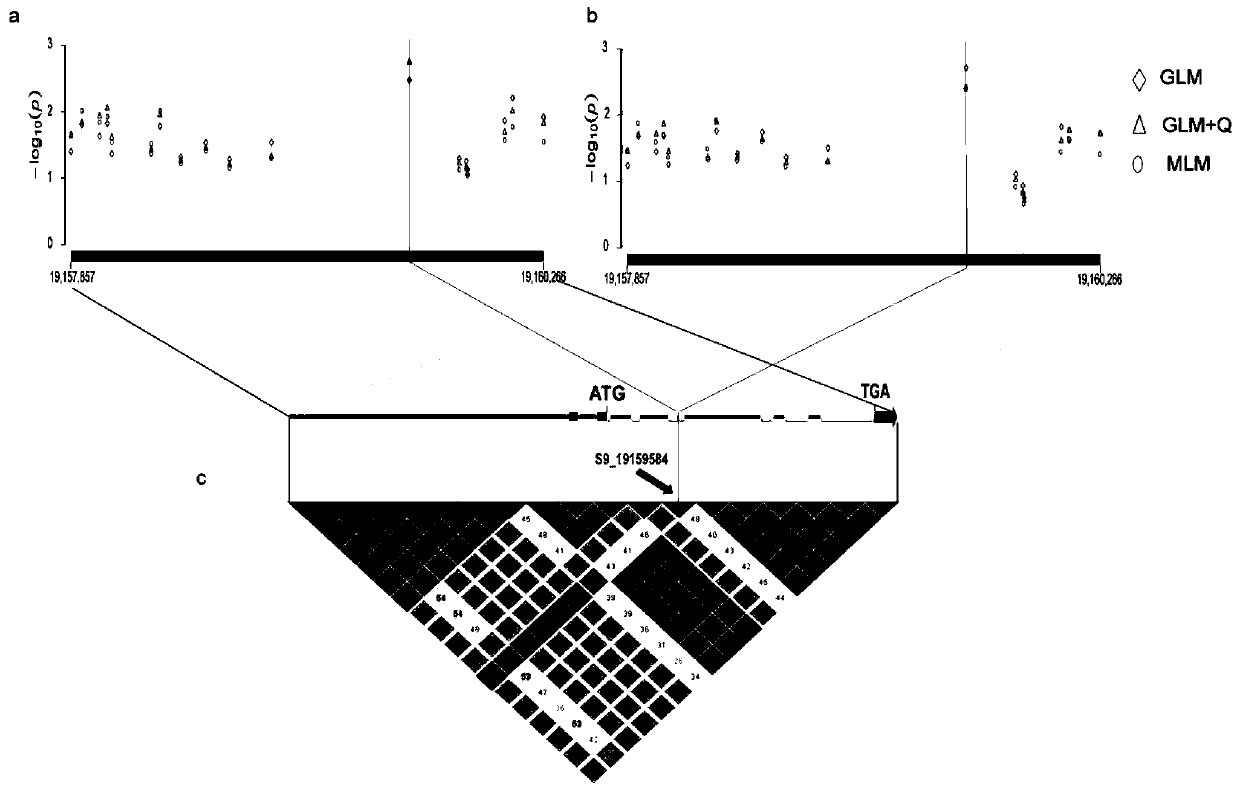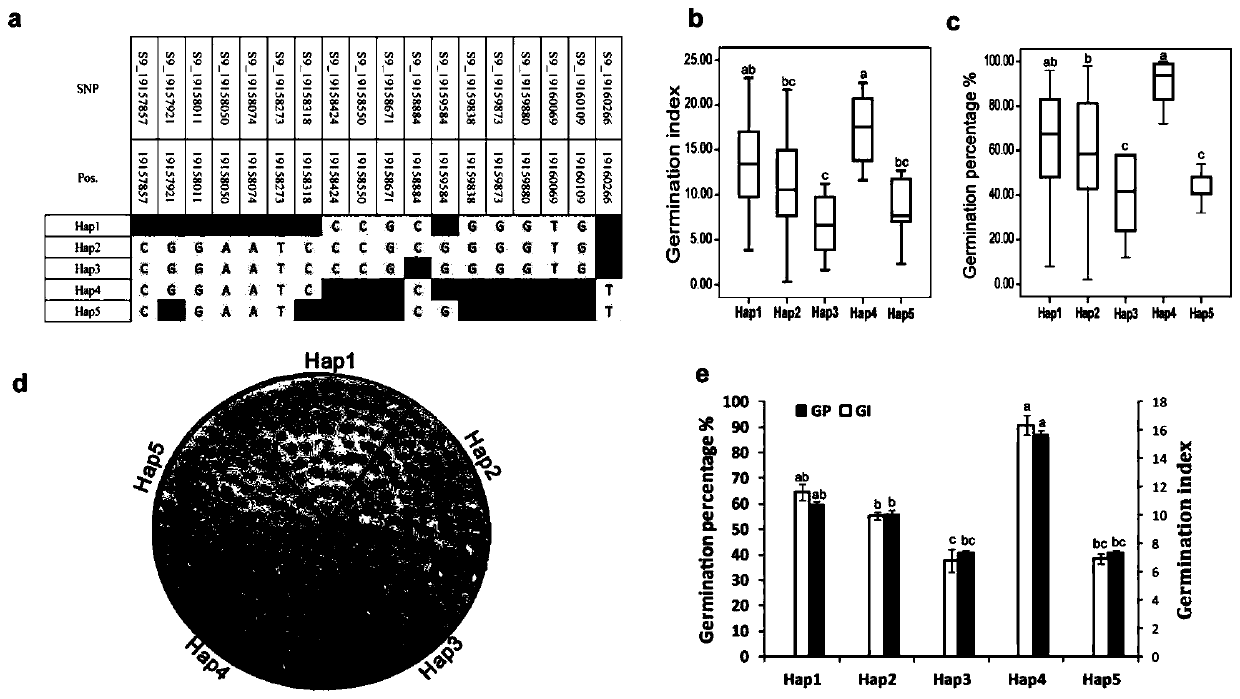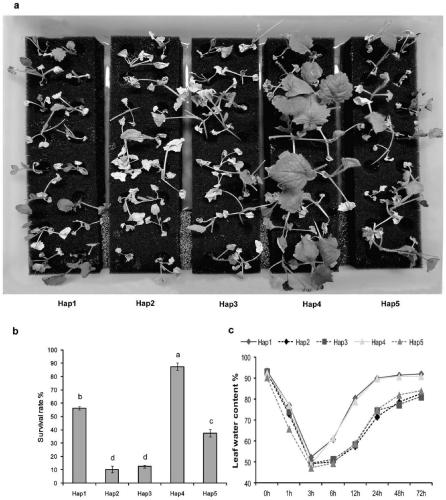Brassica napus drought-tolerant gene, and molecular marker and application thereof
A drought-tolerant technology of Brassica napus, applied in the direction of DNA/RNA fragments, microbial measurement/inspection, recombinant DNA technology, etc., can solve the problems of inability to use molecular markers, labor and time-consuming, time-consuming, etc.
- Summary
- Abstract
- Description
- Claims
- Application Information
AI Technical Summary
Problems solved by technology
Method used
Image
Examples
Embodiment 1
[0038] Example 1: Genome-wide association analysis of seed germination rate (GP) and germination index (GI) of Brassica napus under drought stress
[0039] The 520 germplasm resources used in this example were jointly collected by Chinese rapeseed breeding and scientific research units. For each germplasm resource, 50 plump seeds were selected and sterilized with 4% NaClO solution, and evenly placed in a 0.9 cm diameter petri dish covered with filter paper. For the first time, 30ml 20% PEG6000 solution was added to the drought stress treatment, and 30ml ddH was added to the control 2 o 2 , then add 15ml 20% PEG6000 solution to the drought stress treatment, add 15ml ddH to the control 2 o2 , continued until the 7th day. Carry out 3 repeated experiments, investigate and count germination rate (GP) and germination index (GI). Combined with the genotype data obtained by 60K microarray analysis, the association analysis was carried out based on the MLM model, and the SNPs signi...
Embodiment 2
[0044] Embodiment 2: Haplotype analysis and drought tolerance phenotype identification:
[0045] According to the 18 SNPs detected by resequencing, haplotype analysis was performed, and a total of 5 main haplotypes (Hap, Haplotype) were obtained ( figure 2 a), comparing the GP and GI of these haplotypes under drought stress, it was found that the GP and GI of Hap4 were significantly higher than those of Hap3 and Hap5 (p figure 2 b,c). 20% PEG6000 was used to simulate stress, and different lines of five haplotypes were selected for verification. The results showed that under the treatment of PEG6000, the GP and GI of different haplotype materials were consistent with the previous research results, and the seeds of Hap4 had the highest GP and GI , followed by Hap1, while the GP and GI of Hap3 and Hap5 haplotype materials were lower under PEG6000 treatment ( figure 2 d, e). In addition, the results of comparing the drought tolerance of different haplotype materials at the see...
Embodiment 3
[0046] Example 3: Using BnA.NF-YA7 to target dCAPS molecular markers for drought tolerance identification
[0047] A screening method for drought-tolerant varieties of Brassica napus, comprising the steps of:
[0048] 1) Based on the base site located at 19159584bp on the Brassica napus A09 chromosome, use the dCAPSFinder 2.0 online website to design primers and develop dCAPS markers in combination with the restriction endonuclease NdeI;
[0049] 2) DNA of multiple strains is extracted, and after the following identification, if Brassica napus has the gene sequence described in SEQ ID NO.1, it is a drought-tolerant Brassica napus.
[0050] Specifically, in the step 2), PCR amplification, enzyme digestion and electrophoresis are performed after the DNA is extracted. The PCR amplification procedure is as follows: pre-denaturation at 94°C for 5 minutes; denaturation at 94°C for 30s, annealing at 55°C for 30s, and renaturation at 72°C 1min, 35 cycles; 72°C extension for 10min, 12...
PUM
 Login to View More
Login to View More Abstract
Description
Claims
Application Information
 Login to View More
Login to View More - R&D
- Intellectual Property
- Life Sciences
- Materials
- Tech Scout
- Unparalleled Data Quality
- Higher Quality Content
- 60% Fewer Hallucinations
Browse by: Latest US Patents, China's latest patents, Technical Efficacy Thesaurus, Application Domain, Technology Topic, Popular Technical Reports.
© 2025 PatSnap. All rights reserved.Legal|Privacy policy|Modern Slavery Act Transparency Statement|Sitemap|About US| Contact US: help@patsnap.com



